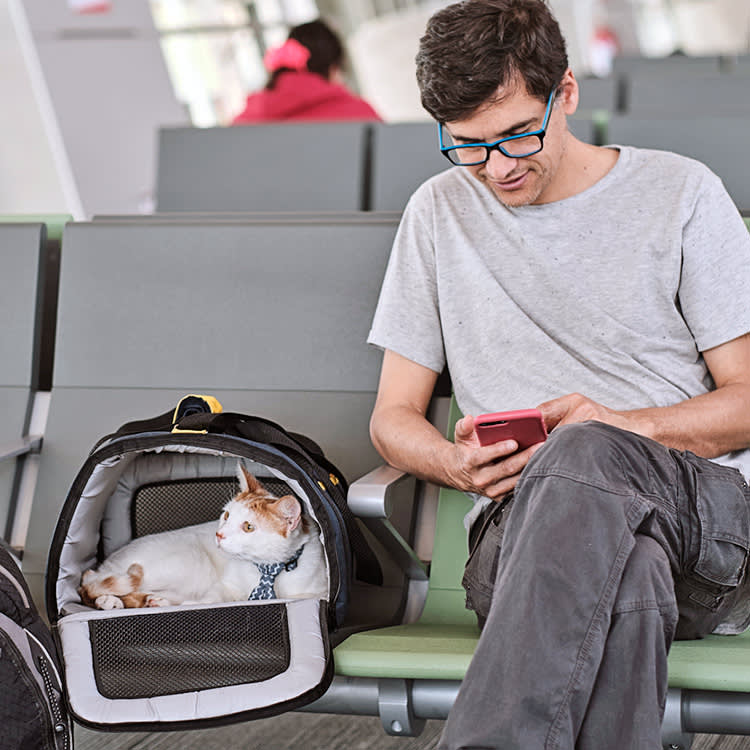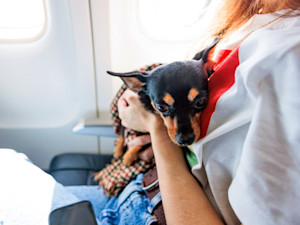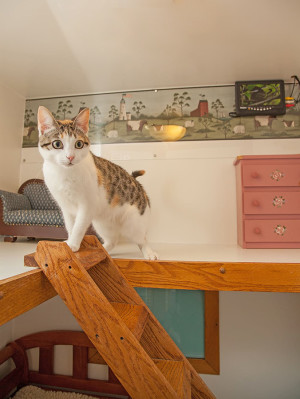Have You Noticed More Cats on Planes? Here’s How to Fly Safely With Yours
TikTok makes it look easy, but flying with a kitty is about more than content creation.

Share Article
These days, it feels like TikTok is full of videos of people flying with their cats. They take them out of their carriers, film content with them in little outfits, and allow them to move freely about the cabinopens in new tab. If creators are to be believed, the whole experience is as stress-free as it is aesthetically pleasing.
Plus, nothing racks up the views quite like cats on a plane to Parisopens in new tab in matching Breton stripes. But is it really so easy to take a cat on a plane? And even if you can bring your cat with you on an eight-hour flight to Europe, should you?
Should you take your cat on a plane?
“It depends,” says Joey Lusvardi, certified cat behavior consultant at Class Act Catsopens in new tab. “If you need to travel because you are moving, that’s one thing, but if your cat doesn’t like being in a carrier or leaving home, then I would argue it is not ethical to force them onto a plane. It’s going to be stressful for them. Do you really need to bring them with you when they would be happier at home with a cat sitter?”
If you are worried, you will miss your cat too much while you are away, Lusvardi suggests getting a video monitor like this one from Furboopens in new tab that allows you to see your pet, talk to them, and even shoots out little treats at the point of a remote. “I don’t have one myself,” he says, “but I really want one. They look great.”

Can you take your cat on a plane?
You can, but the rules for how to go about it can vary significantly based on your airline and destination.
“Many airlines allow cats in the cabin, but with limitations and specific criteria,” says Sarah Pardi, travel expert at Insurteopens in new tab. “American Airlines, Delta, and United all allow it, but each can have its own rules, and they can change those rules at any time.”
When it comes to international travel, Valerie Neyra, marketing coordinator for WorldCare Pet Transportopens in new tab, says Turkish Airlines, Lufthansa, KLM, Air France, and Swiss Air are the most accommodating to feline travelers, however “it it is contingent on the breed of the cat and the intended destination,” she says, “as there can be restrictions on whether pets are allowed in cabin to that country.”
Whichever airline you choose to fly with, make sure you do adequate research before booking your tickets. You’ll want to find out:
1. The maximum number of pets per cabin
“Some flights only allow two pets in-cabin at any given time,” says Pardi. Meaning if two people have already paid for their pets to be in the cabin, you might be out of luck. Even if you buy your cat their own seat, if the per-cabin max has already been reached, you will not be able to take them onboard.
2. Pet weight limits
Often these apply to the cat and their carrier, which many people don’t realize until they get to the airport and discover they are over the limit.
3. Carrier specifications
“Each airline has its own rules about which pet carriers are allowed and which are not,” Pardi says. “Typically, in-cabin carriers have to be soft with a sturdy removable bottom, but it really depends on the airlines.” Some airlines also require that the carrier fit under the seat in front of you, while others will allow you to hold a slightly larger carrier on your lap, even during takeoff and landing.
4. Entry requirements
“If you’re flying internationally, there is going to be some paperwork,” Pardi warns. “It depends on which country you’re heading to, but there will be entry requirements such as updated rabies vaccinations, a functioning microchip, and a clean bill of health, and airlines will need to see this paperwork before boarding.”
5. Additional fees
Sometimes these fees can be paid in advance, other times they must be paid at the airport. If you pay in advance, make sure you have a record of your purchase that includes your flight number and ticketing information printed and ready to show to anyone who needs to see it.
Also, keep in mind that airlines are not required to allow emotional support animals without charging you a fee. “Don’t show up claiming your pet is an emotional support animal and get upset if the airline employees say they have to charge you a fee or that you cannot bring them onboard because you did not let the airline know in advance,” Lusvardi says.
Preparing for your trip
You’ll want to select your airline and book your trip as far in advance as possible to ensure that there is room for your cat in the cabin and that you have time to gather any and all necessary documentation. “Make sure all documents are original and endorsed and that you have physical copies of any airline-specific documents that may be required as well,” Neyra says.
Once you’ve booked your trip, confirm your cat’s reservation and then reconfirm a few days before your departure. “Not confirming the booking ahead of time and then being denied at arrival is one of the biggest mistakes you can make,” Neyra says.
If you need to buy a new carrier for the trip, Lusvardi suggests doing it early enough that you can take the cat on a few shorter trips — to the vet, the grocery store, etc — to help them get used to it. It’s also a good idea to leave the new carrier out on the floor for a few days or more so they can investigate it at their leisure.
If your cat is particularly noise reactive, you can try to desensitize them to the sounds they are likely to encounter on a plane. Lusvardi has a video on YouTubeopens in new tab explaining this process but warns that it can be tricky and advises that you seek out professional help sooner rather than later to avoid doing your cat harm.
Next, you’ll want to take your cat to the vet in the days before your flight to get them checked out. Your vet may need to sign a document saying they are approved to travel, so make sure you bring a physical copy with you to the appointment and fill out as much of it as you can in advance to streamline the process for them. This is also the time to ask about travel-specific medications and how to safely withhold food and water in advance of the flight.
Finally, you’ll need to collect all of your cat’s travel essentials:
1. Pee pads
You’ll need one for inside the carrier on the way there, one for the way back, and a couple extras.
2. Harness and leash
If and when you need to take them out of their carrier, you need to make sure they are tethered to you and a harness is much harder for them to slip out of than a collar.
3. Collapsible food and water bowls
You’ll also want to bring some food, even if you don’t think you’ll need it. After all, flights get delayed and rerouted all the time and just like that, a five-hour trip can turn into a 25-hour journey. If you are bringing wet food, make sure the containers are under 3.4 oz and fit in a clear one-quart zip-top bag, or they will likely be thrown away.
4. Medications
Only use medications or supplements approved by your vet and if they prescribe anything specifically for the flight, make sure you try it out in advance to check for any adverse side effects.
5. Comfort items
If your cat has a favorite toy, add it to their carrier — they’ll need it at your destination anyway. A small, soft personal item that smells like you, like a sock or a washcloth, couldn’t hurt either. And if they like catnip, Lusvardi recommends tossing some of that in, too.
6. Small shawl or blanket
Use this to cover the carrier and give your cat privacy and limit visual stimulation.
Getting through security
When you get to security, you will probably need to remove your cat from their carrier so the carrier can go through the X-ray machine. Make sure your cat is harnessed and leashed before you take them out of the carrier. Even if you think they are super chill and in no way a flight risk, it’s better to be safe than sorry. The last thing you want is them freaking out and running away. What a nightmare!
Padri suggests asking to be taken to a private room before removing the cat from their carrier, but understand that this could significantly delay your trip through security, so if you plan to do this, make sure you arrive at the airport extra early.
In-flight etiquette
Despite what you may have seen on TikTok, cats are usually not allowed out of their carriers on flights. You are, of course, welcome to ask the flight attendants, but if they tell you no, don’t just turn around and do it anyway. You could find yourself banned from future flights.
Even if the flight attendant says it’s fine to take them out, ask your neighbors if they mind first. They paid for their seats just like you did and most likely had a reasonable expectation that they would not be asked to interact with a cat on their flight. You may feel a certain type of way about people who don’t like cats, but you should still respect their position.
If your cat comes out of their carrier at any time, make sure they are wearing their harness and that you’ve got their leash firmly in your grasp. You may think you know how your cat is going to react, but planes are new, crowded, and potentially terrifying environments for a cat, and you don’t want to find yourself trying to recover them from underneath someone else’s seat.
Layovers
Some airports have special pet rooms, but these are usually dominated by dogs and may be overstimulating for cats. Instead, you may want to take them into a self-contained family restroom. Just don’t stay in there for the entire length of your layover. Other people will probably need the space and, besides, your cat may not even feel comfortable there. “It may have weird smells they don’t like,” Lusvardi says. “And once you let them out of their carrier, you may have a hard time getting them back in.”
Whether your cat is in their carrier or not, you will probably have people coming up to you, asking to interact with them. If you or your cat don’t want to engage with strangers, you’ll need to get comfortable saying “no.” In that case, it may also be a good idea to hide the carrier under a blanket or shawl.
To fly or not to fly
Ultimately, the choice of whether or not to take your cat on the plane is yours to make. Just understand that no matter what you may see on TikTok, the fact is that plane trips, for most cats, are neither easy nor fun. “In general, it is really hard to fly with a cat in a way that is actually pleasant for them,” Lusvardi says.
Even if you do everything right, they could still be miserable and if they get too stressed out, it could negatively impact their health and then you’re in another state or a foreign country seeking emergency veterinary help instead of enjoying your vacation. If you can, it’s probably best to leave them at home. They may be sad to see you go, but imagine how happy they will be when you return.

Charles Manning
Charles Manning is an actor and writer based in New York City. In his free time he likes to cook, go swimming at the public pool, volunteer at the LGBTQ senior center, and foster senior and special-needs cats. His work has previously appeared in Cosmopolitan, Elle, Marie Claire, Harper’s Bazaar, Seventeen, and Nylon.
Related articles
![Woman on plane with her small black dog.]()
9 Popular Airlines’ Pet Policies—So You Can Jet-Set Together
We break down the details so you don’t have to.
Should Pets Actually Be Allowed on Planes?
Everyone seems to have an opinion.
![Woman holds her small black dog on the airplane.]()
Turbulence Is Getting Worse—Help Your Pet Weather the Ride
Pre-flight cuddles are OK, but the carrier is safest for your pal the rest of the trip. Here’s why.
![White and brown cat staying at a nice hotel.]()
Sleep-Away Camp For Kitty? The Pros and Cons of Boarding Your Cat
Keep these tips in mind when you’re looking for a quality spot to board your cat.
![Dog sticking its head out the window of a car with mouth open]()
Moving States with Your Pet? How to Make It Happen
Here are some must-dos for your moving checklist.




